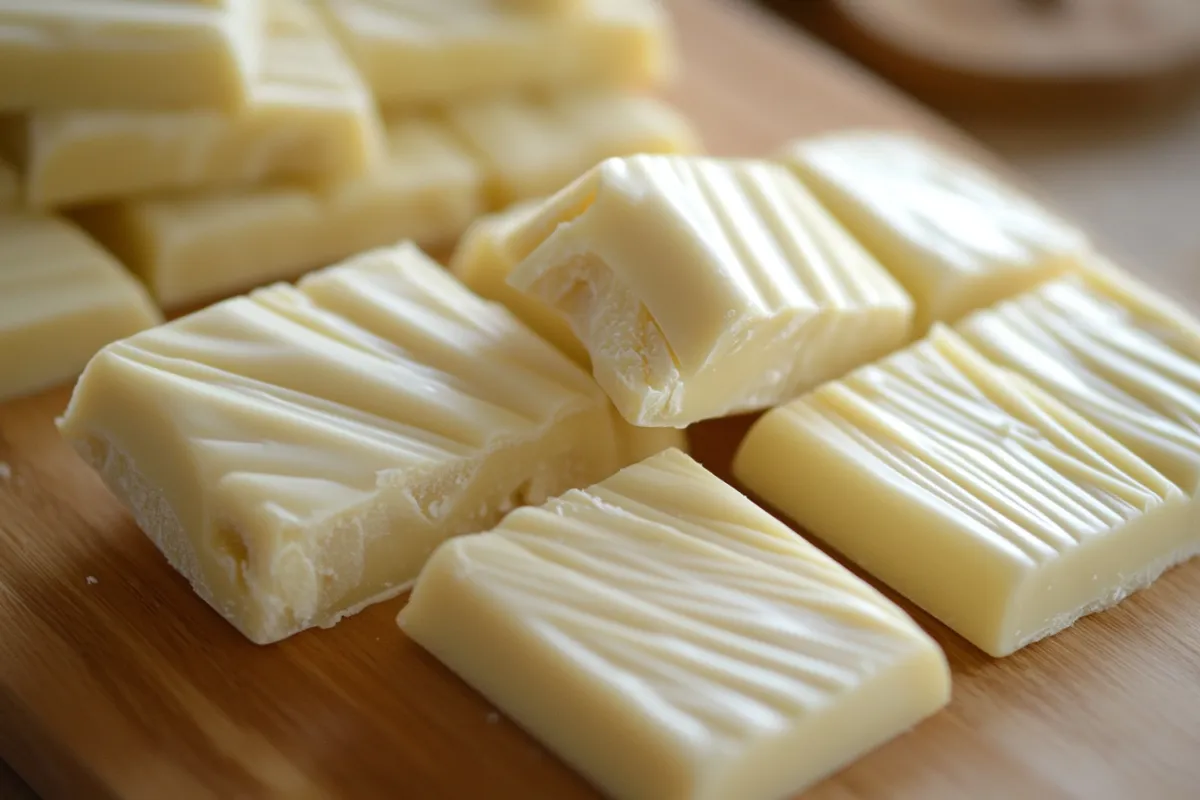Understanding White Chocolate: A Look at Its Place in the Chocolate World
Introduction: The Debate Over Its Authenticity
The status of white chocolate as a legitimate form of chocolate has sparked debate among enthusiasts and experts alike. Unlike its darker counterparts, this confection lacks cocoa solids, which are responsible for the rich flavor and dark color typical of traditional chocolate. This absence has led many to question whether it qualifies as real chocolate. In this article, we explore its composition, production process, and the controversy surrounding this sweet treat. Is it a genuine chocolate product, or does it stand in a category of its own?
What Makes Up White Chocolate?
Key Ingredients
The main components of this confection include cocoa butter, sugar, and milk solids. Unlike dark and milk varieties, which contain both cocoa butter and cocoa solids, this treat is made exclusively from the fatty portion of the cocoa bean. The result is a creamy and sweet product, but without the deep, rich flavor typically associated with traditional chocolate.
- Cocoa Butter: Extracted from cocoa beans, it provides the smooth, velvety texture characteristic of this type of chocolate.
- Sugar: Added to sweeten and balance the flavors.
- Milk Solids: These contribute to the creamy consistency and mild taste.
What’s Missing?
A significant distinction between white chocolate and other types lies in the absence of cocoa solids. These solids are responsible for the intense flavor and dark color of conventional chocolate. In contrast, the pale color and mild flavor of this confection come from cocoa butter, with no input from cocoa solids. This absence has fueled debates about whether it should be considered a true form of chocolate.
A Unique Flavor Profile
Lacking cocoa solids, white chocolate has a distinctive flavor profile. It is sweeter and creamier than its darker counterparts, with a milder taste that highlights the flavors of cocoa butter and milk. While some appreciate this subtlety, others find it lacking in the complexity they expect from chocolate.
Legal Standards for Chocolate Classification
U.S. Regulations
In the United States, the Food and Drug Administration (FDA) has established specific standards for what qualifies as white chocolate. According to the FDA, this product must contain at least 20% cocoa butter, 14% milk solids, and no more than 55% sugar or other sweeteners. These regulations ensure that products labeled as white chocolate maintain a certain level of quality and consistency.
European Guidelines
In Europe, the standards for this confection are similar but with slight variations. The European Union requires that it contain at least 20% cocoa butter and 14% milk solids, closely mirroring U.S. standards. However, European regulations may allow for slight differences in sugar content and the inclusion of additional ingredients, depending on the country.
Global Standards
While U.S. and European regulations are widely recognized, other regions may have different standards. For example, some countries may allow for lower cocoa butter content or different labeling practices. Understanding these variations is essential for consumers who may encounter different versions of this product in international markets.
The Process Behind Making White Chocolate
How Cocoa Butter Is Extracted
The production process begins with extracting cocoa butter from cocoa beans. After harvesting and fermenting, the beans are roasted to develop flavor. The roasted beans are then pressed to separate the cocoa butter from the cocoa solids. The resulting cocoa butter, a pale, fatty substance, serves as the base for making this type of chocolate.
Steps in Crafting the Final Product
After cocoa butter is extracted, it is combined with sugar, milk solids, and any additional flavorings to create the final mixture. This mixture undergoes tempering, a process that carefully heats and cools the chocolate to stabilize the cocoa butter crystals. Tempering gives the finished product its smooth texture and glossy finish. Once tempered, the mixture is poured into molds and cooled to solidify.
Factors Influencing Quality
The quality of this confection can vary significantly depending on the production process and ingredients used. Artisanal versions are often made in small batches with high-quality ingredients, resulting in a more complex flavor and smoother texture. Mass-produced varieties, on the other hand, may use lower-quality ingredients and additives to cut costs, affecting the final product’s taste and texture.
For more insights into what constitutes high-quality chocolate, you can explore the Best Chocolate Brands.
The Controversy: Is It Really Chocolate?
Debating Its Authenticity
The question of whether white chocolate should be considered real chocolate has been debated for decades. The main argument against it is that it lacks cocoa solids, the ingredient that gives dark and milk chocolate their distinctive flavors and characteristics. However, supporters argue that because it contains cocoa butter, a key component of the cocoa bean, it should still be classified as chocolate.
What Consumers Think
Consumer opinions on this type of chocolate vary widely. Some people love its creamy, sweet flavor, while others dismiss it as inferior to dark or milk chocolate. This division often stems from a lack of understanding about what it is made of and how it differs from other types of chocolate. Educating consumers about the ingredients and production process can help them make more informed choices.
Industry Perspectives
Within the confectionery industry, opinions are equally divided. Some chocolatiers embrace it as a versatile and valuable product, while others view it as a marketing gimmick that doesn’t deserve to be called chocolate. Despite this controversy, it remains a popular ingredient in many desserts and confections, and its market continues to grow.
For a deeper dive into the debate, check out Why Is White Chocolate So Controversial?.
Using White Chocolate in the Kitchen
Popular Recipes to Try
White chocolate is a versatile ingredient that can be used in various recipes. It is commonly found in desserts such as cakes, cookies, and truffles, where its sweetness and creaminess can enhance the overall flavor.
- White Chocolate Raspberry Cheesecake: A rich and creamy dessert that pairs the sweetness of white chocolate with the tartness of raspberries.
- White Chocolate Macadamia Nut Cookies: A classic cookie recipe where the mild flavor of white chocolate complements the crunchy, buttery taste of macadamia nuts.
- White Chocolate Truffles: Smooth and decadent, these truffles are a luxurious treat that showcases the creaminess of white chocolate.
Ideal Flavor Pairings
One of white chocolate’s strengths is its ability to pair well with a wide range of flavors. Its mild sweetness allows it to complement both sweet and savory ingredients.
- Fruits: White chocolate pairs exceptionally well with fruits like strawberries, raspberries, and citrus, where the tartness of the fruit balances the sweetness of the chocolate.
- Nuts: Almonds, macadamia nuts, and pistachios add a satisfying crunch and subtle flavor that enhances the creaminess of this confection.
- Spices: Vanilla, cinnamon, and nutmeg are popular spices that add warmth and depth to white chocolate desserts.
Tips for Working with This Sweet Treat
When working with white chocolate, careful handling is essential to maintain its smooth texture and flavor. Here are some tips:
- Melting: Use a double boiler to melt the chocolate slowly and evenly. Avoid overheating, as it can easily scorch or seize.
- Tempering: For confections that require a smooth, glossy finish, tempering is essential. This process stabilizes the cocoa butter crystals, ensuring that the chocolate has a shiny appearance and a smooth texture.
- Storage: Store white chocolate in a cool, dry place away from strong odors, as it can easily absorb flavors from its environment.
Frequently Asked Questions
Is white chocolate technically chocolate?
Yes, white chocolate is technically considered chocolate because it contains cocoa butter, a key component of the cocoa bean. However, it lacks cocoa solids, which are present in milk and dark chocolate.
What makes white chocolate different from milk and dark chocolate?
The primary difference is the absence of cocoa solids. While milk and dark chocolate contain both cocoa solids and cocoa butter, white chocolate is made exclusively from cocoa butter, sugar, and milk solids.
Why do some people say white chocolate isn’t real chocolate?
Some argue that white chocolate isn’t “real” chocolate because it lacks cocoa solids, the ingredient that gives chocolate its characteristic flavor and color. However, others believe that because it contains cocoa butter, it should still be considered chocolate.
Can white chocolate be used as a substitute for dark or milk chocolate in recipes?
White chocolate can be used in place of milk or dark chocolate in some recipes, but the final product will have a different flavor and texture. It’s important to adjust the recipe accordingly to account for these differences.
Does white chocolate contain any cocoa solids?
No, white chocolate does not contain cocoa solids. It is made from cocoa butter, sugar, and milk solids, which gives it its creamy texture and sweet flavor.
Conclusion: White Chocolate’s Role in the Confectionery World
White chocolate occupies a unique and sometimes controversial place in the world of chocolate. While it may lack the cocoa solids that define dark and milk chocolate, it still holds a special appeal for many due to its creamy texture and subtle flavor. Whether or not you consider it “real” chocolate, there’s no denying that this confection has earned its place in the world of sweets.
As you explore different types of chocolate, understanding the composition and characteristics of each can enhance your appreciation for this beloved treat. Whether you’re a fan of white chocolate or prefer its darker counterparts, there’s a place for all types of chocolate in the world of desserts and confections.
For more on the history and variations of chocolate, you might find it interesting to read about the History Behind Chocolate or explore the Best Chocolate Brands.

